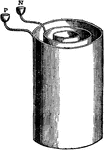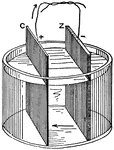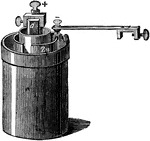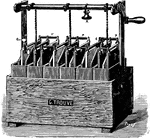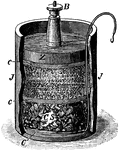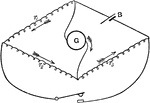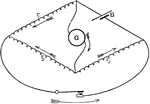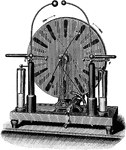
Whimhurst Machine
Two oppositely rotating glass discs connected to seperate Leyden jars generate electricity. -Atkinson…
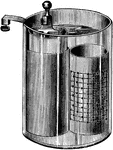
Daniel Cell
The first two-fluid cell was incented by Daniell, and English electrician in 1836..." -Atkinson 1903
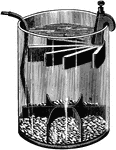
Gravity Cell
"The electric resistance of the porous cup employed in the Daniel cell, and the local action produced…
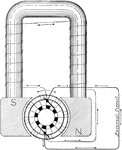
Shunt Wound Dynamo
"When a dynamo is so constructed that only a smal part of its current is employed to magnetize its field-magnet,…

Connected dynamo and motor
"Where a motor is connected with the electric circuit of a dynamo...and the armature of the dynamo is…
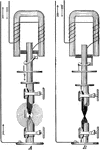
Carbon Arc Lighting
Arc lighting, which used two carbon rods conducting electricity to produce light. -Atkinson 1903

Electroscope
"One of the simplest instruments of this kind consists of a metallic needle, terminated at each end…
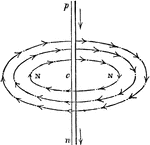
Circular Motion of the [Electric] Fluid
"Thus, if we suppose the conducting wire be placed in a vertical situation, as shown, and p, n, the…
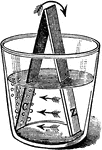
Current Electricity
"Take the zinc from the tumbler of acid and, while it is yet wet, rub thereon a few drops of mercury...replace…

Induction Machine
"Machine used to generate electricity by induction using transformed kinetic energy from the crank."…
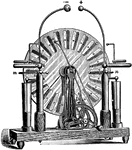
Wimhurst Machine
"The Wimhurst machine is used to generate small amounts of static electricity which are then stored…

Arc Lamp
"The arc lamp is essentially a device for automatically separating the carbons when the current is turned…
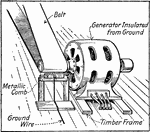
Using a Grounded Metallic Comb to Reduce Static Charge, Perspective View
"Method of using a grounded metallic comb near the driving belt to relieve the belt of static charges."…
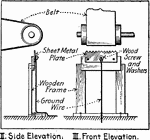
Using a Grounded Metallic Comb to Reduce Static Charge, Front and Side View
"Method of using a grounded metallic comb near the driving belt to relieve the belt of static charges."…
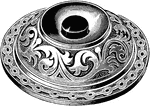
Push Button
"The push-button...is well known in connection with the electric bell: a brass spring which forms part…

Electric Meter
A small electric meter that measures electricity in units called kilowatts-hour. The first meter is…
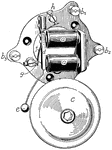
Electric Bell
An illustration of an electric bell. "The magnetizing coils are a a, and they are connected with their…
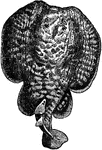
Torpedo
Torpedo is a group of rays, commonly called electric rays or torpedoes. It is the only genus in the…
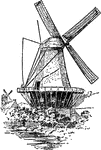
Windmill
A windmill is a machine that is powered by the energy of the wind. It is designed to convert the energy…

Windmill
A windmill is a machine that is powered by the energy of the wind. It is designed to convert the energy…
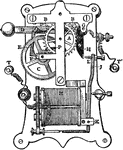
Electrical Remontoire
An electrical remontoire can be either a gravity or spring type. In it, the weight or spring is rewound…

Trough Battery
The trough battery was a variant of the Voltaic Pile and was invented by William Cruickshank c1800.…
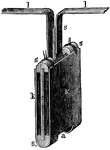
Wallaston's Battery
In Wollaston's battery, the wooden box was replaced with an earthenware vessel, and a copper plate was…

Wallaston's Battery
In Wollaston's battery, the wooden box was replaced with an earthenware vessel, and a copper plate was…

Grove Cell
An illustration of Bussen's cell.The Grove cell was an early electric primary cell named after its inventor,…
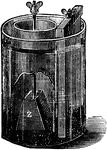
Fuller Bichromate
The cell was set up in a glass, or glazed earthenware, pot. This contained the chromic acid solution,…
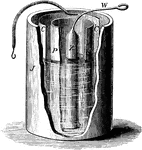
Daniell Cell
The Daniell cell (var. sp. Daniel cell), also called the gravity cell or crowfoot cell was invented…

Fleming's Standard Cell
In semiconductor design, standard cell methodology is a method of designing Application Specific Integrated…
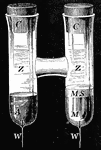
Clark's Standard Cell
In semiconductor design, standard cell methodology is a method of designing Application Specific Integrated…

Arc Lamp
An electric arc lamp by Brush Electric Company. Arc lamps produce light by an electric or voltaic arc.

Arc Lamp
An electric arc lamp by Brush Electric Company. Arc lamps produce light by an electric or voltaic arc.

Dynamo Machine
The armature of a dynamo machine by Brush Electric Company. The dynamo machine, now known as an electrical…

Dynamo Machine
The dynamo machine, now known as an electrical generator, is a device that converts mechanical energy…

Frictional Electric Machine
Now known as electrostatic generators, the Frictional electric machine produces static electricity at…
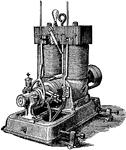
Electric Machine
Thomas Edison's original concept of the electric machine, an electricity generator distributed to homes,…
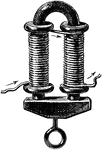
Electromagnet
"A magnet which owes its magnetic properties to the inductive action of an electric current." -Whitney,…
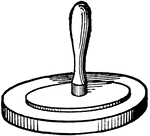
Electrophorus
Alessandro Volta's design of the electrophorus. "An instrument for obtaining statical electricity by…

Pith-Ball Electroscope
"An instrument for observing or detecting the existence of free electricity, and, in general, for determining…
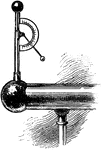
Quadrant Electroscope
"An instrument for observing or detecting the existence of free electricity, and, in general, for determining…

Condensing Electroscope
"An instrument for observing or detecting the existence of free electricity, and, in general, for determining…
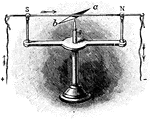
Galvanometer
A galvanometer is a type of ammeter; an instrument for detecting and measuring electric current. It…

Differential Galvanometer
"The galvanometer consists of two distinct coils of wire, each having the same resistance, and having…
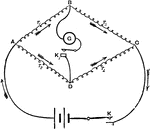
Arrangement of Battery, Resistance, and Galvanometer
"Represents in diagram the arrangement of the battery, resistance, and galvanometer. There are two keys,…

Battery Resistance
An illustration of the assisting and opposing method used to measure battery resistance.

Potentiometer
A potentiometer instrument for measuring the potential (or voltage) in a circuit taps off a fraction…
!["The Metre Bridge is employed - a piece of apparatus which is illustrated [here]. It consists of a wooden base, upon the upper face of which is mounted a metallic rectangle; three sides of this rectangle are formed by a broad substantial copper band - having a negligible resistance - and the fourth consists of a platinum silver wire w w joining the copper blocks P and p. This wire is exactly one meter long, and over it slides a key K, which when depressed makes contact by means of a platinum knife-edge with the wire; the exact point on the wire at which this contact is made is indicated by an arrow-head on the key, which slides against a scale, as shown." (Britannica, 1891)](https://etc.usf.edu/clipart/61300/61365/61365_metre-bridge_mth.gif)
Metre Bridge
"The Metre Bridge is employed - a piece of apparatus which is illustrated [here]. It consists of a wooden…
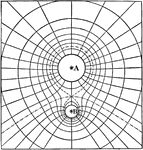
Equipotential
"Equipotential Lines about two similarly electrified spheres, A and B, the quantities of electricity…
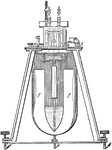
Quadrant Electrometer
An illustration of a quadrant electrometer. An electrometer is an electrical instrument for measuring…
